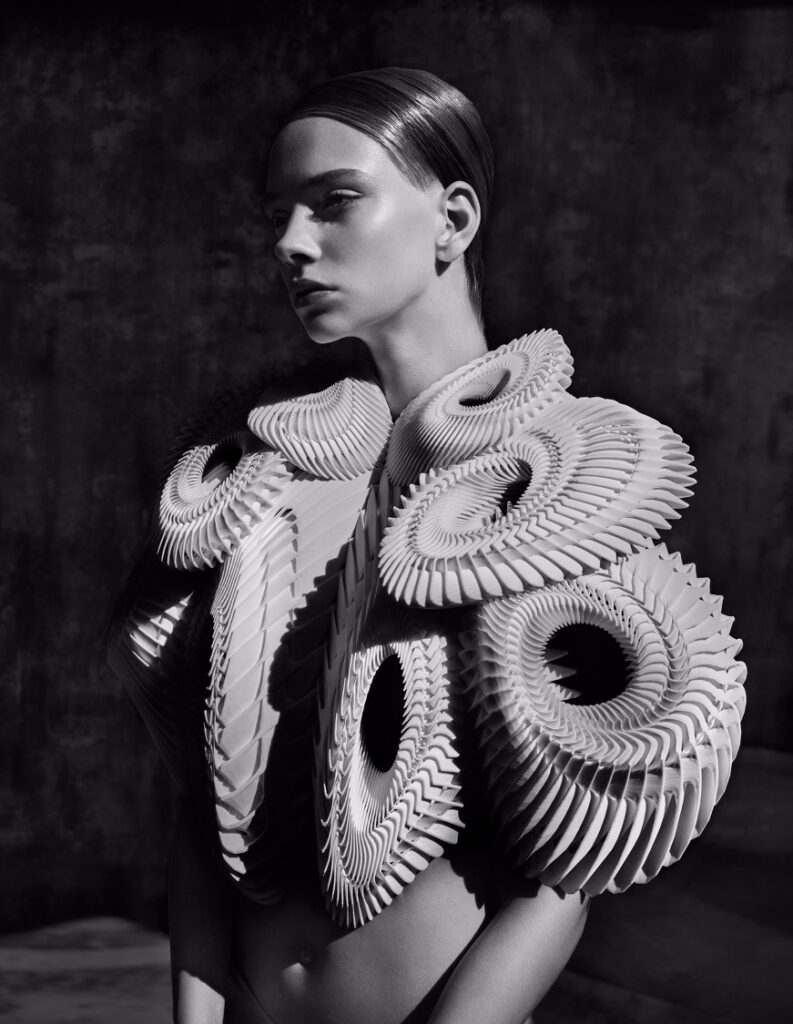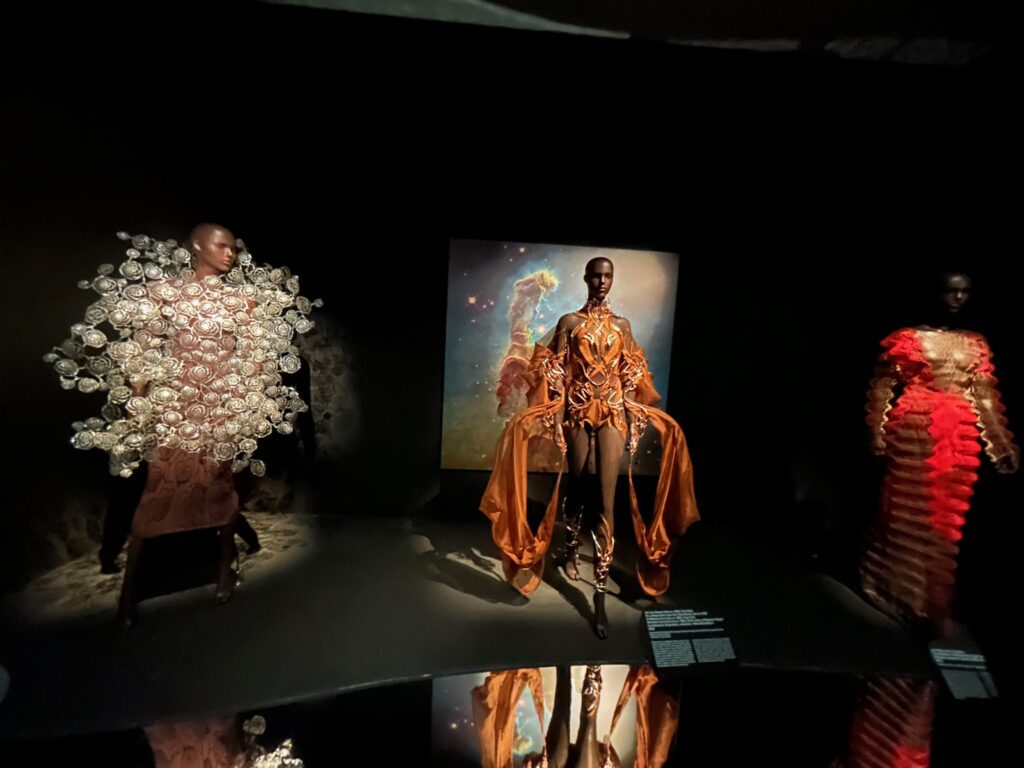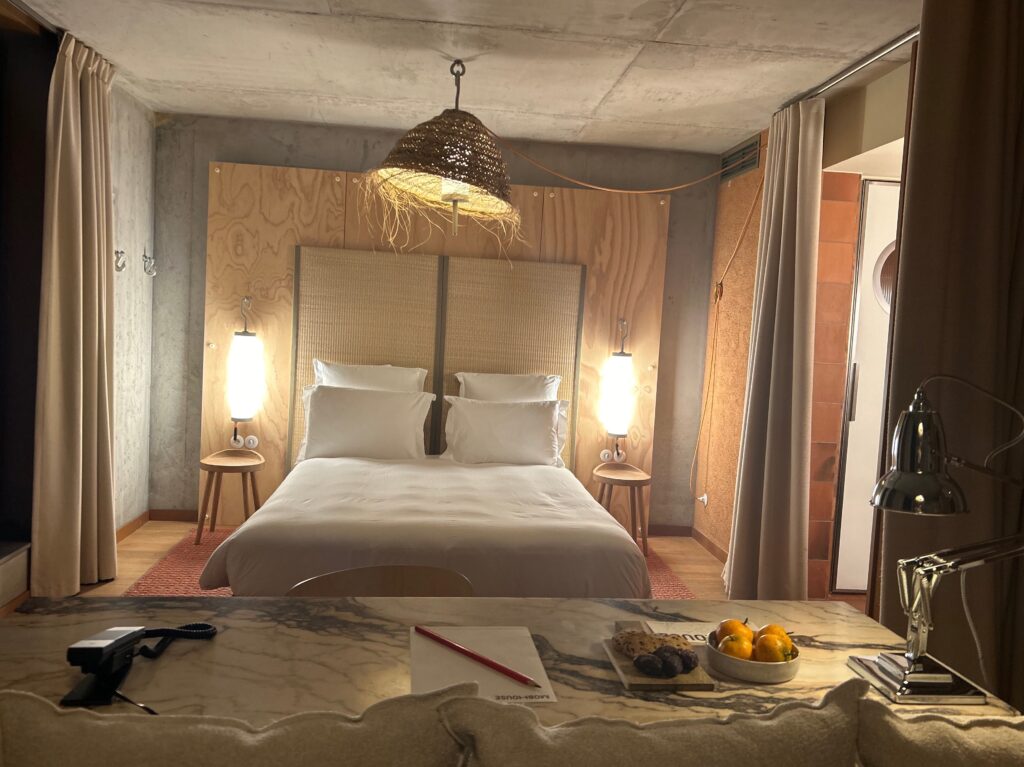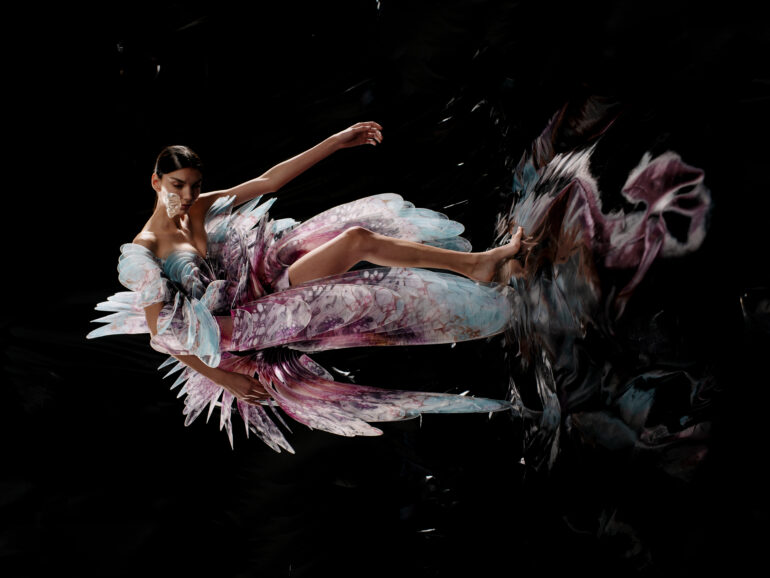Iris Van Herpen “Sculpter les Sens” (“Sculpting the Senses”) at the Musée des Arts décoratifs.
Culturalee visited Paris to review the Iris van Herpen exhibition “Sculpting the Senses” at the Musée des Arts décoratifs and stayed at the Mob House in Saint Ouen.
Described by the Musée des Arts décoratifs as “One of the most avant-garde creatives of her generation”, Dutch haute couture designer Iris van Herpen is a true creative innovator. Van Herpen’s oeuvre pushes the boundaries of fashion design, crossing over into fine art, textiles, science and nature. “Sculpting the Senses” a truly immersive experience that stimulates all the senses through installations, sound, video and sculpture, and juxtaposes Van Herpen’s exquisite fashion designs with work by contemporary artists that complements or inspires her artistic practice. “Sculpting the Senses” pays tribute to one of the most forward-thinking fashion designers in recent history. A pioneer in the use of new technologies in her discipline, van Herpen transgresses the conventions of fashion design, while embracing Couture craftmanship and exploring new technologies. At the heart of her creative practice is a rejection of fast fashion and a pioneering approach towards utilising new technologies in environmentally-friendly ways, for example using eco-responsible manufacturing methods in certain creations made from recycled plastic or 3D printed cocoa beans.

Photo courtesy of Iris Van Herpen
Far more than a fashion exhibition, “Sculpting the Senses” takes visitors on an immersive journey from micro to macro, a multi-sensory ride through the incredible universe created by Iris Van Herpen. Her commitment to slow fashion and multi- disciplinary approach transcend the boundaries of Haute Couture and push the limits of the imagination.
”Sculpting the Senses” is curated by Cloé Pitiot and assistant curator Louise Curtis, with the scenography by Studio Nathalie Crinière. A curated selection of over 100 haute couture Iris van Herpen pieces showcasing her design experimentation and textile innovation are presented in the Christine & Stephen A. Schwarzman Galleries. Sound designer Salvador Breed was commissioned to create an immersive sound composition for the exhibition.
Van Herpen’s couture creations are displayed to provoke a dialogue with works of contemporary art by artists including; Philip Beesley, Wim Delvoye, Damien Jalet, Kohei Nawa, Casey Curran, Rogan Borwn, Jacques Rougerie and design pieces by Neri Oxman, Ren Ri, Ferruccio Laviani, and Tomáš Libertíny. Highlights of the contemporary art on display include a vast hyperrealistic wave installation by Japanese collective Mé and a feather sculpture by British artist Kate MccGwire, whose Colab369 scarf collection can be found in the museum shop. Also featured are curated objects from the spheres of the natural sciences, which are a constant source of inspiration to Van Herpen, such as skeletons and fossils.

Installation view of Iris Van Herpen Haute Couture and sculpture by Kate MccGwire. Photo credit: Lee Sharrock
Staged at the iconic decorative arts museum adjacent to the Louvre, the Iris Van Herpen exhibition has a lot to live up to, following in the footsteps of the critically acclaimed Elsa Schiaparelli exhibition “Shocking! The Surreal World of Elsa Schiaperelli” in 2022. Van Herpen’s creations are so exquisite, innovative and complex that they are a worthy successor to Schiaperelli’s Surrealist creations that graced the MAD galleries last year. As well as the fact that they are both women, it’s interesting to note several threads connecting the oeuvre of Dutch contemporary designer Van Herpen with the legacy of the early 20th Century designer Schiaperelli – their creativity, innovation and interest in pushing the boundaries between fashion and art. Schiaperelli founded her eponymous label in 1927 and injected humour into fashion by drawing inspiration from nature and life to apply hands to belts, cicadas on buttons, claws on gloves and aspirin on necklaces. She was pioneering in her use of materials, recycling newspapers clippings into fabric, repurposing a thermometer as an earring, and creating a perfume bottle inspired by the torso of a woman years before Jean Paul Gaultier. Schiaperelli’s creativity and star power gave her access to a glittering demi-monde of artists and designers in 1920s Paris, including Man Ray, Picasso and Jean Cocteau.
Around a century later and Van Herpen has in a a way taken on the mantle of Schiaperelli of innovator and progressive fashion designer, while Starlets, Supermodels and Divas including Beyonce, Lady Gaga and Kate Moss queue up to wear her designs. French First Lady Brigitte Macron and Queen Maxima of the Netherlands attended the Van Herpen private view, with the Dutch Royal describing the couturier as “a Dutch artist of the very first order” and “the woman who gave a new dimension to fashion, whose every dress is an adventure and an enigma.”
‘Sculpting the Senses’ really is an assault on the senses, with themed rooms taking visitors on a journey through multi-sensory experiences themed around different eras of the couturier’s collections. The exhibition ends with a presentation of Iris van Herpen’s works as if projected in the immensity of the cosmos. Her dresses dance across the sky, with bodies floating through space and time. The photographic works of artist Kim Keever, as well as images of nebulae encourage visitors to experience the world in a more holistic fashion.

Photo credit: Lee Sharrock
The theme of the skeleton is inaugurated by the Skeleton dress echoing the hybrid skeleton of a work by Japanese artist Heishiro Ishino. The place of the body is also evoked at the heart of organic and architectural networks, represented by means of a dress, a metaphor for a Gothic cathedral, but also by Ferruccio Laviani’s Gothic cabinet, and a documentary by Yann Arthus- Bertrand and Michael Pitiot entitled Terra, committed to the defence of life and the interconnections between ecosystems. Next, visitors are invited to leave the physical dimension of their body to explore the sensory world and through photographs by Tim Walker, a sculpture by Matthew Harrison. Finally, the shadows of mythology around the theme of the medusa created by Phillip Beesley enter into a dialogue with works by Kate MccGwire, EcoLogicStudio and a piece of Samurai armour. In the next section dedicated to new nature, the installation Living Shadows by Beesley comes to life as a derivative of physical dress and infiltrate its surroundings. An installation by Casey Curran offers a reflection on the place and the physical and spiritual future of human beings.
Celebrating her unique approach, this retrospective, organized around nine themes, identifies the essence of her work, merging fashion, contemporary art, design, and science. The theme of water and the origins of life, omnipresent in the designer’s work, opens the exhibition. Her latest collection, entitled Carte Blanche, showcased in this space, dialogues with David Spriggs’ work Origins, literally inviting the visitor to immerse themselves in the designer’s aquatic universe. A special space reveals the natural environments invisible to the naked eye already unveiled in the 19th century in the illustrations of Ernst Haeckel or in the remarkable glass models by Léopold and Rudolf Blaschka. Works by Ren Ri and Tomáš Libertíny, made by bees, contrast with the fragility Rogan Brown’s paper works.
Three spaces bring the exhibition to a close: an evocation of Iris van Herpen’s studio, in which vistors are immersed into the atelier process through hundreds of material samples, a cabinet of curiosities presenting her accessories (shoes, masks, and hairstyling items), alongside elements from the natural sciences and videos, and a room celebrating the living and moving body through videos of the designer’s catwalk shows.
Born in 1984, Iris van Herpen grew up in the village of Wamel (Netherlands) in harmony with nature and the living world, which are, along with the classical dance she practiced intensively from an early age, the founding elements of her relationship to the body and clothing. After a formative period with Alexander McQueen and Claudy Jongstra, she founded the Maison Iris van Herpen in Amsterdam in 2007, combining the subtleties of craftsmanship with the pioneering spirit of innovation, decompartmentalising and opening up her practice to a host of other disciplines, resulting in sensorial design that capture the intricacy and diversity of a natural world.
Four years later, she joined the Chambre Syndicale de la Haute Couture in Paris. The year 2010 marked a turning point in her career: she presented her first 3D-printed dress from the Crystallization Collection, currently conserved by the Musée des Arts décoratifs. In the manner of the iconic piece made in collaboration with Daniel Widrig and the Materialise company, Iris van Herpen contemplates fashion as an interdisciplinary language and a dynamic entity, the result of the cross-pollination of various fields: art, chemistry, dance, physics, architecture, biology, design, and technology.
Iris van Herpen. Sculpting the Senses” is at the Musée des Arts Décoratifs, 107, rue de Rivoli until 28th April, 2024: https://madparis.fr/Iris-van-Herpen-Sculpting-the-Senses
IG: https://www.instagram.com/irisvanherpen/

Photo of Mob House by Lee Sharrock
Culturalee stayed at Mob House in Saint Ouen, the result of a collaboration between iconic French designer Philippe Starck, entrepreneur Michel Reybier and vegan pioneer and philosopher Cyril Aouizerate. The trio conceived Mob House as an eco-aware destination in the eclectic Saint Ouen region of Paris, close to the world-renowned Marché des Puces where eagle-eyed art, antiques, fashion and interior design lovers can pick up antique and vintage objets d’art, furniture and clothes.
Mob House and it’s neighbouring sister enterprise Mob Hotel are community and environmentally aware, and have instigated a partnership with a local school, as well as running a community garden and employing locals. The ethos of Mob Hotel’s interiors is part pared-back industrial with exposed metal and roughly plastered terracotta walls, mixed with great attention to sourcing natural artistanal materials such as rice-straw headboards and wall paint mixed from clay and straw. Plastic bottles are banned and Mob Hotel’s restaurant serves mainly vegetarian, seasonal fare made from locally sourced organic ingredients.

Photo of Mob House by Lee Sharrock
Mob House is at 70 Rue des Rosiers, 93400 Saint Ouen: https://www.mobhouse.com/fr/house/galerie.html



